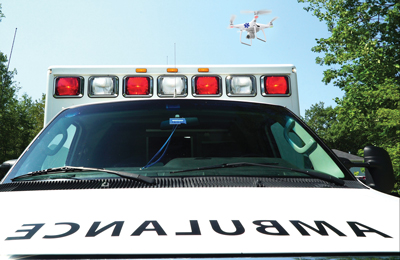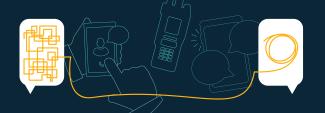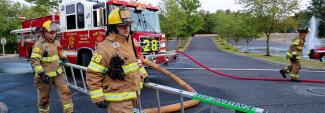With FirstNet available throughout the United States, emergency managers have greater access to real-time information than ever before. Charles Murph says that now is the time to think about how to manage the ever-larger volumes of data that will ensue.
This blog is a repost from the December 2018 edition of Crisis Response Journal (Volume 14, Issue 1).
The age of FirstNet stands to deliver situational awareness and data for Emergency Operation Centers (EOCs), whether for emergency managers in rural or metro areas in the US. When police needed to search a 300-acre wooded property in rural Alabama, they used a mix of traditional police work and cutting-edge technology to try to find evidence that could provide a long-sought break in a missing persons case.
With state and local law enforcement, fire, and EMS resources on hand, first responders set up a command centre to oversee a search that included cadaver-sniffing dogs and trained divers to explore a pond on the property. Along with these on-the-ground resources, the search was aided by drones streaming aerial footage and a mobile mapping application from ESRI.
The Alabama Emergency Management Agency was tasked with developing the incident action plan and providing interoperable communications for the event. So the agency reached out to FirstNet.
Powering the connections among first responders and these advanced tools was a cell on wheels (COW) vehicle that linked the mobile devices to FirstNet, the nationwide US public safety broadband network (see CRJ 13:2). The connection allowed personnel to take pictures of points of interest and send them back to the mobile command centre in real time, while bringing in footage from the drones and data from the mapping application. The FirstNet devices also allowed mobile command staff to see the location of search teams in real time, enhancing the safety of officers involved in the search, while outlining areas of the property that had been searched. Together, these resources provided unprecedented situational awareness and allowed responders to search the land more effectively and thoroughly than was previously possible.
What can be confirmed is how the power of mobile devices and applications running over FirstNet contributed to the success of the effort. This new nationwide wireless network for first responders is transforming the work of public safety and supporting command and EOCs during emergencies and large-scale operations and events.
The FirstNet Authority was created in 2012 by an act of the US Congress. Lawmakers allocated a powerful band of LTE spectrum to public safety and provided $7 billion in initial funding. The money, which was funded by spectrum auctions, was never believed to be adequate to fund the deployment and management of an entirely new nationwide network. In addition, the founding legislation mandated that the network be self-sustaining – meaning it could not draw on additional federal funds.
To address these challenges, the FirstNet Authority entered into a first of its kind public-private partnership with AT&T. The FirstNet Authority provides oversight of the contract with AT&T, the latter being responsible for building, deploying and maintaining the network, pricing, plans and customer support.
FirstNet has been available to public safety subscribers for months and thousands of agencies have signed on across 52 US states and territories.
Subscribers to FirstNet have absolute network priority and can pre-empt all other network traffic. This means first responders have access to a network that transmits life-saving data when they need it most. In addition, services that require high speeds and greater bandwidth, such as video streaming, will be available even when the general public standing nearby is unable to access the Internet owing to heavy use and congestion.
The FirstNet core network went live in March 2018. This fully separates public safety traffic from commercial traffic and allows for enhanced security on the nationwide public safety broadband network. Data transmitted over FirstNet is encrypted from user equipment to the radio access network to a backhaul network to the core before terminating at the respective agency’s servers.
FirstNet will also expand broadband coverage, especially in rural areas, so that responders can use mobile devices in areas prone to poor access or reception. In addition, AT&T has a network of 72 deployables that are pre-positioned throughout the country so they can be rapidly dispatched to establish or restore connections.
This partnership is also accelerating the transition of commercial-focused technology for the benefit of public safety users. There are already a number of FirstNet certified and FirstNet approved devices and applications available. With the support of AT&T and the FirstNet Authority Lab, FirstNet is inspiring and nurturing a vibrant technology and applications developer community by opening the doors to more developers through its FirstNet Apps Catalogue. FirstNet provides developers with support and tools, and promotes the vision of a fully integrated technology and communications ecosystem for public safety.
Synthesizing Data
Whether overseeing a search operation or helping a community respond to extreme weather or managing a large-scale incident, the goal of the emergency manager is to bring as much data as possible into the EOC and then to synthesise it into the most meaningful and complete picture of the current situation to share with other public safety and government officials.
The process has become faster and more streamlined in recent years, as applications focusing on GIS and EOC management have come into widespread use, allowing emergency managers to create dashboards and reports that put crucial information at their fingertips. Inefficiencies in the current system do remain, however, owing to the fact that some information is relayed by phone or email, meaning reports are often pushed out only once every operational period, and the reach of the gathered information is limited.
With FirstNet now deploying nationwide, the ability to gather and disseminate information at the EOC will reach the next level. When public safety personnel out in the field have a strong wireless connection that is guaranteed through network priority and pre-emption, the crucial work of emergency managers is faster and more efficient.
The FirstNet network also facilitates the ability to manage large scale incidents at the scene, rather than relying on the multi-tiered response required when the EOC is off site. Rural emergency managers are getting out in the field more and more and bringing the operations centre with them, by running applications such as WebEOC and Code Red on a tablet or laptop. Mobile command centres can operate on tools that can fit into a backpack, as long as the connection is strong and reliable, giving command staff on scene more resources and faster access to information.
Imagine a situation in which a chemical truck has overturned on a rural highway close to a neighbourhood subdivision. If emergency management personnel can set up right on the scene with the incident commander, they’ll have the connectivity needed to support the response along with fire, EMS, and law enforcement. Some incident commanders may use emergency managers in their logistics section, thus providing the quick ability to mobilise mutual aid resources like hazard materials teams and transportation assets for evacuations.
Improved Situational Awareness
This co-ordination helps provide improved situational awareness to first responders, public officials and those who are keeping the public informed on vital details such as road closures and evacuation orders. It also prevents a lag in information delivery and dissemination. By the time the information is gathered at the EOC and shared with first responders, in a fast-moving incident, some elements of the situation may have already changed. With FirstNet providing the robust wireless connection needed to take in and disseminate a large amount of data, first responders have more information available to them, faster than ever before.
Advanced tools and the availability of FirstNet will allow much more information to flow in and out of the EOC. In fact, the data may soon do more than just flow, it may begin to flood in. An emerging problem may lie in how to manage the flow of information and quickly sort through what is useful and what is not. If responders in the field are sending in so much tactical data, how will one or two emergency managers or even a team of emergency managers process it? Before long there will need to be more emphasis placed on analyzing data in the emergency management community.
Emergency managers will soon face a multitude of questions regarding the receipt, analysis, visualisation and verification of information from public safety personnel. Here are just a few questions emergency managers should start asking:
- How are we going to triage the data when it comes in?
- How are we going to manage it and who will manage it?
- How will the data be secured?
- How will public safety receive, catalogue, visualise and store the data from Internet of Things devices?
- Will public safety IT managers and chief information officers (CIOs) have a bigger role in emergency management? and
- How will EOCs receive or share data with other public safety entities, fusion centres, weather centres, other local/regional/state EOCs?
The emergency management community, for the most part, is not equipped and built to be the hub for all of this information. That’s why I believe it is critical for emergency managers to have relationships with CIOs who manage their jurisdiction’s IT infrastructure. The CIOs should be the first stop for emergency managers when determining the best way to capitalise on the availability of this data.
Emergency management will also reap the benefits of FirstNet by:
- Finding solutions for hazard mitigation;
- Planning strategies with smart city concepts;
- Utilising the Internet of Things to identify, track and manage resources; and
- Capitalising on before/after GIS imagery to forecast damage assessment information in near-time following a major disaster.
Emergency managers have been starving for information for so long; public safety may soon have the opposite problem.
And while too much information is a good problem to have, the issue will still need to be addressed, thoughtfully and collectively.




















